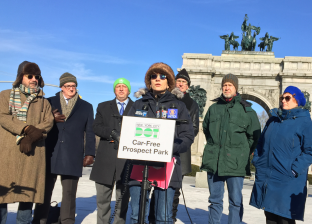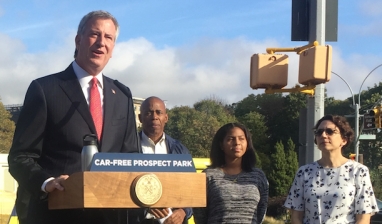De Blasio Gets More Cars Out of Central Park and Prospect Park

Starting in a few weeks, people will be able to enjoy the Central Park loop north of 72nd Street and the west side of Prospect Park year-round without having to worry about motor vehicle traffic, Mayor de Blasio and Transportation Commissioner Polly Trottenberg announced this morning. The changes will significantly reduce motor vehicle traffic in both parks while stopping short of making either completely car-free.
“Today we’re taking a big step toward returning our parks to the people,” de Blasio said at a presser in Prospect Park this morning. “We’re creating safe zones for kids to play in, for bikers, for joggers, for everyone.”
For the last few summers, the city has kept cars out of the Central Park loop above 72nd Street. On June 29 that car-free zone will become permanent. The Prospect Park West Drive will go car-free July 6.
The road on the east side of Prospect Park — which is also the less affluent side of the park — will remain a traffic shortcut during the weekday morning rush, as will 72nd Street and the southwest segment of the Central Park loop. The Center Drive, linking Sixth Avenue to 72nd Street, will stay open to traffic from 7 a.m. to 7 p.m. every weekday.
De Blasio framed the changes as the next step in the progression toward completely car-free parks. “A lot of people looked forward to this day and look forward to us taking further steps in the future,” he said.
For years, advocates have chipped away at traffic in both parks, and drivers have adjusted their behavior. “As we’ve gone through the stages, we’ve been pleasantly surprised that there haven’t been traffic impacts,” said de Blasio.
The expansion of car-free zones has also shrunk the level of traffic dramatically during the times when people are allowed to drive through the park loops. In 1991, said Trottenberg, traffic peaked at 2,500 cars per hour on the Central Park loop. Now the traffic volume is down to 300 to 400 cars per hour on most of the loop. On the west side of Prospect Park, there are now just 200 cars per hour.
But in City Hall’s estimation, traffic levels are not low enough to make the parks completely car-free. The south end of Central Park gets about 400 to 500 cars per hour, said Trottenberg, and there is twice as much traffic on the east side of Prospect Park as the west side. “For now, we don’t want to spill all those cars into the street,” she said.
Getting cars out of Central Park and Prospect Park entirely enjoys broad public support. Transportation Alternatives collected 100,000 signatures for a car-free Central Park in 2005, and all the community boards bordering the park voted to make the whole park car-free for the summer in 2011.
Tens of thousands of Brooklynites have signed on to make Prospect Park car-free. When de Blasio was in the City Council representing the 39th District, he led a contingent of four council members calling for a summer car-free trial.
Those campaigns still have a fight to wage after today’s announcement.





